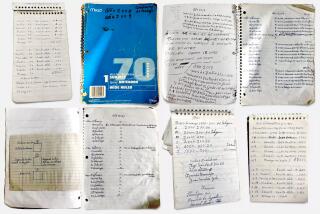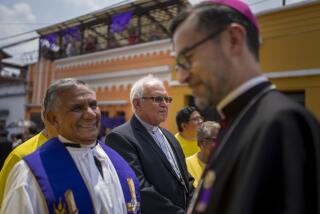Medical HELP to Get Philippines on its Feet
Sister Therese Kohles picked up a stack of color snapshots of her recent trip to the Philippines and spread them across a table in her office at St. Joseph Medical Center in Burbank.
“This is a delivery room in one of the regional hospitals,” she said. The bare, dirty room and rickety table looked more like part of a prison. Sister Therese picked up another snapshot. “Here’s an 18-year-old Muslim boy in the hospital for Mindanao region. He was caught in a cross fire between insurgents and the army and lost part of the bone in his leg. There’s no way they can do a bone graft. We arranged to have him looked at by an American hospital ship in April, if he lasts that long.”
She pointed to a photo of a row of plywood and sheet-metal hovels. “Here’s a garbage dump right in Manila they call Smokey Mountain, and 20,000 people live there. They scavenge for a living. There’s no running water. Believe me, this trip changed my whole idea of Third World poverty.”
11 Tons of Supplies
A nurse who serves as assistant administrator of mission effectiveness for St. Joseph Medical Center, Sister Therese was one of 25 health-care professionals taking part in Project HELP, or Hospital Emergency Lift, Philippines. In a five-day visit in late February and early March, the group took 11 tons of medical supplies and equipment to the fledgling government’s hard-pressed hospitals. Another four tons are to be sent later by ship.
Project HELP is an effort of the Hospital Council of Southern California and the Los Angeles-based Operation California, a group that has arranged similar missions to other needy countries. China Airlines, with headquarters in Taiwan, donated transportation.
The Project HELP delegation met Philippine President Corazon Aquino, one of the highlights of the trip for Sister Therese.
“We gave her a box of medical supplies that symbolized all the things we brought. She’s a tremendously strong and popular person. Because of her, the women in the Philippines have become very strong.”
Shortage of Basics
Sister Therese said the Philippines needs basic equipment that Americans take for granted. “Tongue depressors, stethoscopes, antibiotics. We gave them incubators, a mammography machine, vaccines,” she said. “What they have for patients is minimal.”
Gray-haired, with hazel eyes and silver-rimmed glasses, the 62-year-old nun has been a member of the Sisters of Providence order for 40 years. The Montreal-based order owns St. Joseph and 16 other West Coast facilities, including hospitals and schools. Sister Therese has worked in hospitals in Anchorage and Seattle and in a multi-program child center in Portland.
“Seeing the extreme need that exists in the Philippines made me want to help,” she said. “It would be wonderful to work there, but, after 40 years, I don’t think I could adjust psychologically to that world, as much as I’d want to. So I’ll do what I can from here.”
She said she will urge the order’s corporate officers to “adopt” a Philippine hospital and make regular gifts. She also hopes to find doctors to volunteer for one-month duty tours.
“There are 7,000 islands in the Philippines,” Sister Therese said, “and that’s one of the problems. They become so disconnected from each other. There are places where the people don’t even expect health care. And there are a lot of mental-health problems, because of the stress. With all the fighting and no jobs, can you imagine?”
Studies by the United Nations, the World Health Organization and several international relief agencies have found that tens of thousands of Filipinos die each year because of the shortage of hospitals, medical equipment, medicines and doctors. Charges abound that the backward conditions stem, in part, from corruption in the regime of deposed President Ferdinand E. Marcos.
In a story last month, Mark Fineman, chief of the Los Angeles Times’ Philippine bureau, wrote, “According to documents obtained by The Times and interviews with present and former political leaders, many of the national and local officials in the Marcos administration routinely diverted huge sums of government health-care funds to favorite or political projects.”
Outside agencies found that the country’s health problems include an infant mortality rate of 44%; malnutrition among 79% of all preschool children; the highest incidence of whooping cough, diphtheria and rabies in the world, and a measles epidemic that kills thousands of children each month.
“Measles is a conquered disease in the U.S., but not in the Philippines,” said David Langness, vice president of communications for the Hospital Council of Southern California and director of Project HELP. “The sole cause is a shortage of measles vaccine.”
Seeks More Participation
Langness said the airlift was the first effort at international aid undertaken by the Hospital Council. Fewer than half of the organization’s 220 members donated to the drive, he added. Besides St. Joseph, AMI Tarzana Regional Medical Center and the San Fernando Valley operations of CIGNA Co. took part. Yet Langness hopes that participation in Project HELP will grow.
“The real goal is to set up a long-term sister-hospital network where administrators will go over, see the conditions and adopt a Philippine hospital,” he said.
Such continuing relationships were initiated on the trip, he said.
“For instance,” Langness said, “we were at Tondo Hospital in Manila, where they reuse surgical gloves, and one of our party saw the gloves drying on a rack and told the people there, ‘We’ve got hundreds of these we throw away every week because the surgeons don’t like the way they fit. I’ll send you some.’ So now Tondo will get new surgical gloves.”
Langness bristled when asked if his example, including as it does the discarding of unused supplies in a U.S. hospital, isn’t a serious comment on the wastefulness of health care in this country.
“First of all, there is an enormous amount of luxury in every area of American life, not just medical care,” he said. “So the leftovers can be of great help to a country that’s 40 or 50 years behind.”
Andrea Aquino Luna, a dietitian at Pioneer Hospital in Artesia who made the trip, also cited the historical closeness of the Philippines and the United States as a reason for increased health-care aid. The archipelago was ceded by Spain to the United States in 1899, after the Spanish-American War, and was ruled by the United States until independence was granted in 1946.
“A lot of people forget that there is a special relationship between the two countries,” said Luna, a native of the Philippines and second cousin to Benigno (Ninoy) Aquino, President Corazon Aquino’s late husband. “It’s a very Americanized place.”
Luna is a member of the Ninoy Aquino Movement, a group named for the opposition leader after he was assassinated when returning from exile in 1983. Luna said the group formed to rally anti-Marcos support in the United States and elsewhere, but has turned from political to social action now that democracy is established in the Philippines.
“Project HELP is somewhat a response to the cry we’ve been putting out,” Luna said. “Because of the economic status there and the very poor conditions, we have done a lot of humanitarian projects. Water and sanitation are the most important problems in the Philippines. It’s very crowded. People on the farms who aren’t doing well have come to the city . . . They live in shanties.”
Luna said the scope of Project HELP has been “much more than we could have done just from the Philippine community.” Although conditions in her homeland remain difficult, Luna said she found on her recent trip that “people looked a lot happier.”
“I think eventually they’ll be able to help themselves,” Sister Therese said. “But, if we help them now, during this period of transition, it can make a real difference.”
More to Read
Sign up for Essential California
The most important California stories and recommendations in your inbox every morning.
You may occasionally receive promotional content from the Los Angeles Times.










